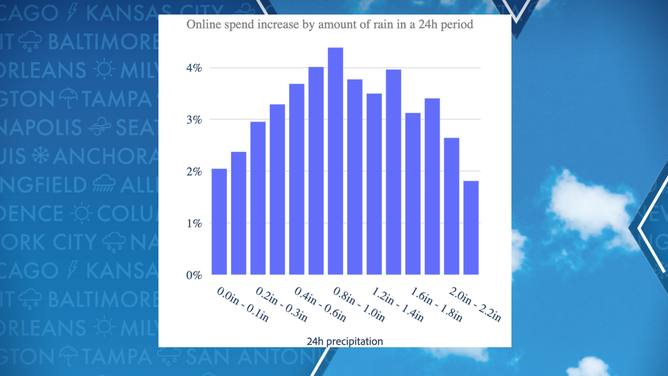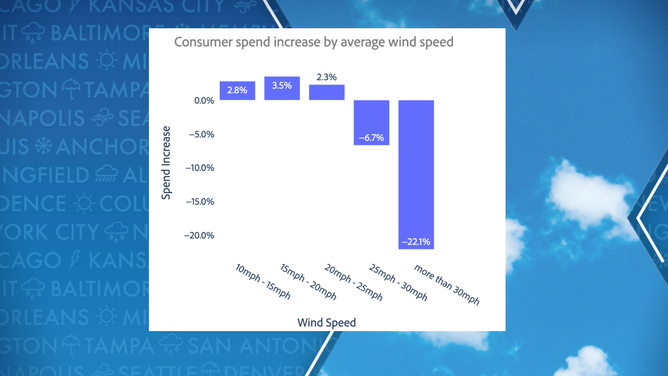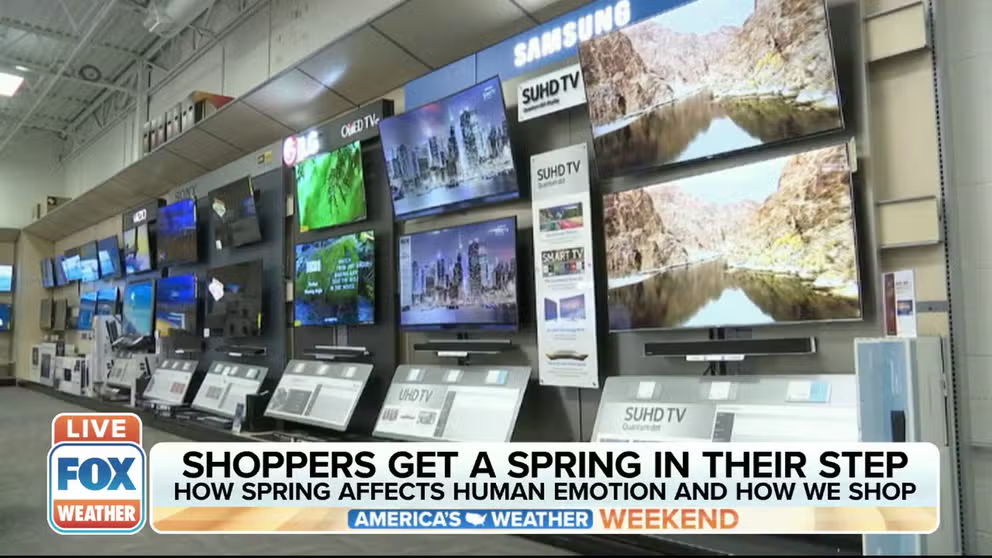Can bad weather trigger your online spending habits?
Rainfall has the most significant effect on consumers’ habits over snow and wind. According to the Bureau of Labor Statistics, consumers spend a yearly average of $66,928.
How spring affects shopping habits
BreezoMeter's Paul Walsh joins FOX Weather to talk about how springtime has an impact on our emotions and how we shop.
It is not a secret that when the weather is frightful, malls and shopping centers can become proverbial ghost towns, but a new analysis from Adobe shows that rain or snow doesn’t tamp down on consumers’ urge to splurge.
Analysts at the computer software company recently broke down data from IBM’s The Weather Company and projected that inclement weather could result in an additional $13.5 billion in online spending. The amount is not pocket change and rivals spending during many holidays, including the always busy Cyber Monday.
Analysts examined snow, wind and rain impacts on consumer spending habits, and the results were surprising.
Rainy days were responsible for most consumer changes, followed by wind events, but snow played less of a role in habits than many would imagine.
UPS METEOROLOGISTS WORK TO KEEP AMERICA MOVING
The severity of each weather event also likely plays a part in setting the moods for shoppers, and Adobe analysts found that when Mother Nature reaches an extreme level, there is quite a decrease in spending.
Analysts found that rain impacts on consumer sentiments usually reached its peak when 0.8 – 1 inch of rain fell during a 24-hour period and spending trailed off when precipitation got heavier. A light to moderate rain boosted spending by over four percent, but the advantage dropped significantly when at least two inches of rain was reported.
Adobe found the sentiment was exemplified over the weekends when the effect of rain on shopping is twice as robust.

Online spending by rainfall amount
(Adobe / FOX Weather)
Similar to rain, if winds don’t get strong and potentially impact infrastructure such as electricity or the internet, shoppers will continue to spend online until gusts reach the stage of negative effects.
Adobe said for a city such as Atlanta, a 25 mph wind can decrease online shopping by 30 percent, and once winds reach a level that can occasionally do damage, a drop-off by 90 percent or greater can be expected.
Certain regions perform differently than others, and the impacts of wind depend on a community’s tree canopy as well as the state of the infrastructure.
A city such as Denver or Chicago can withstand impacts from greater wind speeds than a city such as Knoxville, Tennessee, or many other eastern cities.
ANTARCTICA’S ‘DOOMSDAY GLACIER’ IS MELTING AWAY DIFFERENTLY THAN SCIENTISTS FIRST THOUGHT

Online spending vs wind speed
(Adobe / FOX Weather)
According to Adobe’s research, snowfall impacts on consumer habits varied greatly by city, and just because flakes fly across a region, it doesn’t mean behavior changes with the weather patterns.
Shoppers in cities where snowfall is considered to be a rarer occasion tended to leave their devices behind and possibly go out and enjoy the winter wonderland.
Those areas that receive a more moderate amount of snow per year, 20-80 inches, tended to shift to more online shopping during events.
The analysts found that in communities with significant yearly snowfall, the impacts from light winter events don’t account for too much, with shoppers likely shrugging off the inconvenience and venturing about.
VIDEO CAPTURES TORNADO CROSSING PATH OF MASSIVE CRUISE SHIP IN MISSISSIPPI RIVER
If weather patterns follow expectations, Adobe projected rainfall events will account for some $8.7 billion, winds could result in additional spending of $4 billion and snowfall will have a much smaller effect.
"As more of our daily lives move online, and the digital economy expands, it is critical for brands to proactively prepare for moments when ecommerce activity will pick up. Weather events that keep consumers home and boost online spending present opportunities for retailers to better personalize and deliver great experiences across digital channels. Capitalizing on weather can yield returns comparable to big online shopping moments such as Black Friday or Cyber Monday," an Adobe senior analyst wrote in a blog post.
